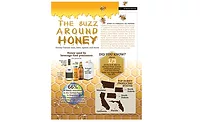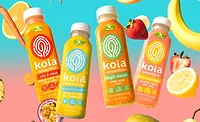Honey receives sweet honor
Ingredient recognized for its versatility, functionality
The pop song “Sugar, Sugar” by The Archies contains the catchy line “Honey, honey, ah, sugar, sugar, you are my candy, girl, and you got me wanting you.” Although they weren’t singing about beverages, “honey, honey” is being used as a “sugar, sugar” substitute by beverage-makers and health-conscious consumers in hot and iced teas, water, and more.
Each year, the Princeton, N.J.-based Firmenich, identifies and celebrates the year’s most distinctive, trending flavor as a way to acknowledge consumer preferences. This year, honey received the honor. Honey’s popularity has seen consistent growth in recent years as consumers gravitate toward food and beverage products that are considered artisanal and crafted, or locally sourced, flavor company Firmenich said in a statement.
“You can just do so much with honey. For a flavor that is as sweet as honey is, it shows remarkable versatility,” says Firmenich Senior Flavorist Patrick Salord. “Depending on the application, you can tone down the sweetness or even tone it up. There’s no limit in its potential, and people respond to that.”
The National Honey Board is seeing a significant increase in made-with-honey beverages in all categories, including spirits, beers, ready-to-drink (RTD) teas and waters. “The demand has been significant, and we expect it to continue based on consumer trends. Honey’s versatility is another key reason we see an increase in demand,” notes Catherine Barry, director of marketing for the National Honey Board.
Many consumers view honey as a healthy sweetener, which helps in its marketability, Barry says. “Every mom is familiar with honey and has a positive perception of the ingredient. As more parents analyze what ingredients are in the food and drinks they give their children, the use of an all-natural sweetener like honey will only grow in importance.”
Barry says that honey also has revolutionized the alcohol industry. “Honey is being used by craft brewers and distilled spirit manufacturers for its flavor properties,” she says. “The whiskey category has completely changed with the addition of honey varieties, and we’re seeing the same with honey-flavored vodkas. On the craft beer side, honey helps provide a smooth flavor profile in wheat beers, ales, lagers and stouts.”
In mid-March, Deerfield-based Beam Suntory Inc., released Hornitos Spiced Honey, which features 100 percent blue agave Hornitos Plata Tequila infused with natural honey flavor, vanilla and a spice blend.
Functionality and flavor
In the non-alcohol beverage market, honey is being increasingly used by beverage processors for its functionality and flavor, Barry says. Honey provides a sweetening element that lends itself to clean-label trends.
The RTD tea segment also has embraced honey, a natural fit for this brewed beverage. “Many processors, including Lipton and Honest Tea, have honey varieties to strengthen their flavored tea lines. …In energy drinks, the 17 grams of carbohydrates per tablespoon of honey allows energy drink manufacturers to launch a product that retains a clean label and a needed energy boost,” Barry says.
A wide range of notes
Similar to wine, honey is greatly impacted by geographic location, climate, soil and temperature (also known as terroir). In North America alone, there are more than 300 types of honey that vary in flavor, color and aroma. Depending on the terroir and the pollens bees have gathered, honey can reveal a wide range of notes, experts say. “Honey flavor can contain anything from light and delicate white flowers such as chamomile, lily of the valley or linden to powerful and heady flowers such as jasmine or rose,” Firmenich’s Salord says. “And that’s not all. Honey can also contain notes similar to dried flowers such as lavender, as well as animalic and leathery notes typical of acacia. You can find woody, piney and even smoky notes.”
For specialized needs and to attain a specific profile, Barry says beverage processors use popular honey varieties such as orange blossom, buckwheat or clover, while beverage producers typically source varieties like tupelo, pomegranate or star thistle for smaller processors and limited run products.
Although U.S. consumers have an insatiable appetite for honey, experts note that there are simply not enough bees in North America to keep up with the demand. The National Honey Board’s Barry says that roughly two-thirds of the U.S. honey supply is imported from other countries, such as Vietnam, Argentina and Canada.
The health and vitality of honey bees is of great importance to the National Honey Board, it says. “Not only do honey bees produce honey, they also provide a vital benefit to agriculture through pollination of many food crops," Barry says. "Honey is simply honey, purely made in a beehive. Not many sweeteners carry such marketing cache.”
Looking for a reprint of this article?
From high-res PDFs to custom plaques, order your copy today!




